Clay pots make perfect food storage because they're naturally non-reactive and chemical-free while actively preserving your food's nutrients and flavors. You'll benefit from their porous structure that allows food to breathe while maintaining ideal moisture levels, and their mineral composition enriches stored items with calcium, iron, and magnesium. They'll keep your produce fresh through natural evaporative cooling, lowering temperatures up to 10°C below the surrounding environment – all without electricity. Using clay storage also supports sustainable practices and reduces food waste. There's so much more to discover about this ancient yet remarkably effective storage solution.
Natural Chemical-Free Storage Solutions
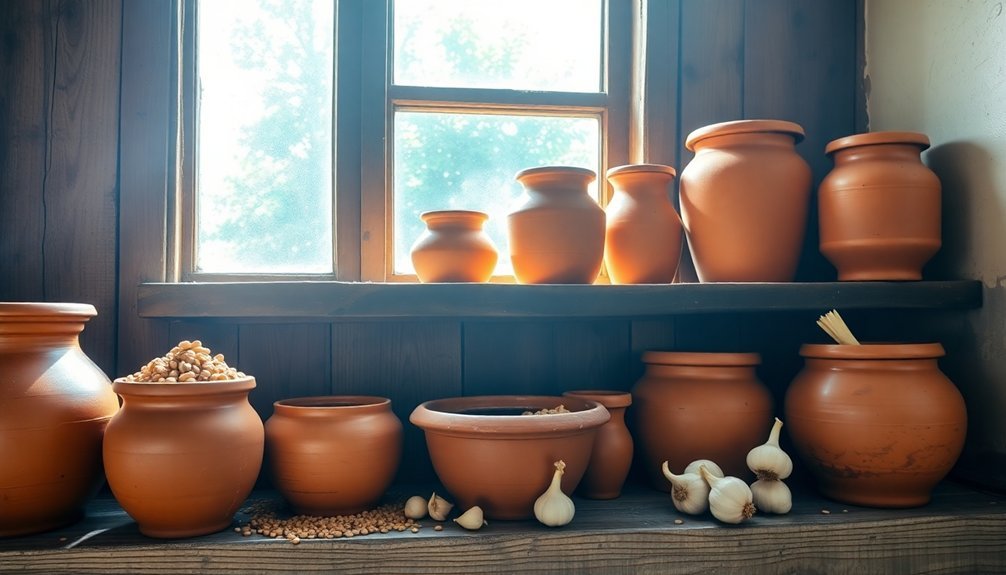
Natural clay pots offer a compelling alternative to conventional storage containers, though their safety depends considerably on proper treatment and glazing. When you're looking for chemical-free storage solutions, properly glazed clay pots can provide a safe, non-reactive environment for your food without introducing synthetic materials into your storage system.
You'll find that high-quality clay pots, especially those made from 100% ceramic clay and free from metals like lead and cadmium, won't leach harmful substances into your food when properly glazed.
While unglazed pots can pose risks due to potential heavy metal content, you can minimize these dangers through proper treatment methods, such as boiling water and cooking rice in new pots before use. Similar to FSC-certified wood, choosing certified clay pots ensures sustainable and responsible sourcing practices.
The natural composition of clay includes beneficial minerals like calcium and magnesium, but you'll need to be cautious about potential aluminum and antimony content.
That's why choosing glazed options is essential – they create a protective barrier that prevents unwanted elements from reaching your food.
Unlike plastic containers, clay pots won't release synthetic chemicals, and they don't absorb odors or flavors, ensuring your food stays pure and uncontaminated.
Ancient Wisdom Meets Modern Storage
Beyond the safety considerations of clay storage, there's profound wisdom in these time-tested methods that's finding new relevance in modern homes.
You'll discover that clay pots aren't just containers; they're sophisticated tools that have preserved food effectively for thousands of years through their natural evaporative cooling properties. The natural clay material ensures no harmful chemicals leach into stored foods.
When you use clay pot storage, you're tapping into a system that can maintain temperatures up to 10°C below the surrounding environment without electricity.
You'll find this particularly valuable in areas with limited access to modern refrigeration or if you're seeking sustainable alternatives. The pots work through simple physics – as water evaporates from the outer surface, it creates a cooling effect that keeps your produce fresh longer.
The storage method also aligns with modern concerns about food waste and environmental impact.
You won't need to shop as frequently since your produce stays fresh longer, and you're not consuming electricity for storage.
The pots' ability to regulate humidity naturally means you're preserving food without artificial preservatives or chemicals, making it an ideal solution for today's health-conscious households.
Clay's Cooling Powers
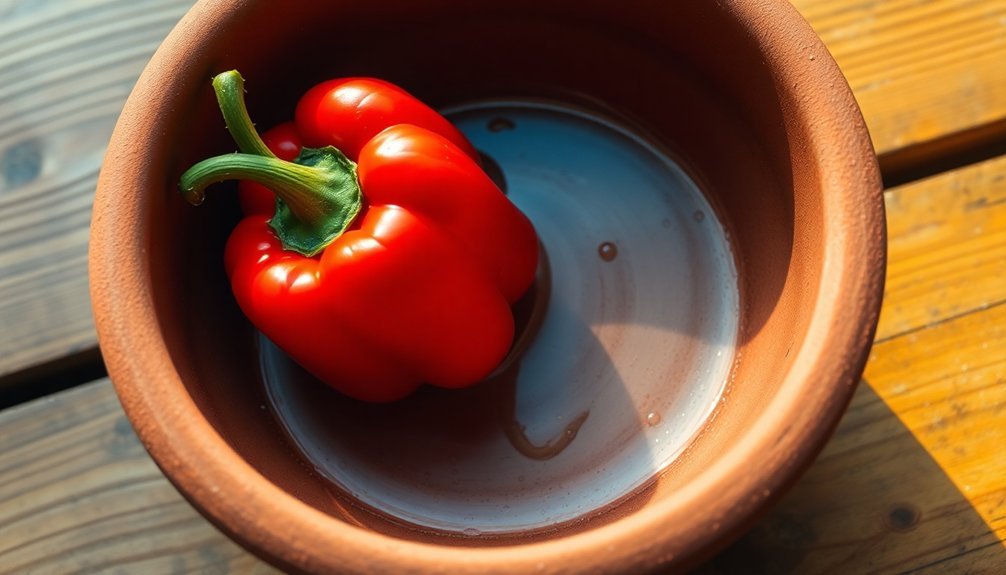
While modern refrigeration relies on electricity, clay pots achieve remarkable cooling through a simple yet ingenious natural process. When water evaporates from the clay's surface, it draws heat away, creating a natural cooling effect that's similar to how your body cools through sweating. The proven effectiveness of these coolers has made them particularly valuable in high-temperature regions with limited resources.
You'll find that these pots can lower internal temperatures by up to 10°C below the surrounding air, while maintaining humidity levels above 90%. This combination creates perfect conditions for food preservation.
| Food Item | Regular Storage | Clay Pot Storage |
|---|---|---|
| Leafy Greens | 1 day | 4+ days |
| Tomatoes | 3 days | 7 days |
| Eggplants | 4 days | 8 days |
| Cucumbers | 3 days | 7 days |
| Cabbage | 5 days | 14 days |
To maximize your clay pot's cooling power, you'll need to nest a smaller pot inside a larger one, with damp sand between them. Keep your pot in a shaded, well-ventilated area, and cover it with a wet cloth. You'll need to clean it regularly and verify the sand stays moist for peak performance. This simple setup can extend your produce's shelf life by 50% to 600%, saving you time and reducing food waste.
Preserving Food Without Electricity
Ancient civilizations mastered food preservation long before electricity existed, and these time-tested methods remain valuable today.
You'll find that clay pots play an essential role in these preservation techniques, particularly through evaporative cooling systems like Zeer pots, which can extend your food's shelf life up to 20 days.
When you're looking to preserve food without electricity, you've got several proven methods at your disposal:
- Set up a Zeer pot by placing a smaller clay pot inside a larger one, filling the gap with wet sand, and covering it with a damp cloth – this can lower internal temperatures by up to 10°C.
- Create an underground root cellar to control humidity and temperature naturally, similar to how your ancestors stored vegetables through winter.
- Try fermentation using salt brines to preserve vegetables while creating beneficial probiotics and distinctive flavors.
- Use traditional canning methods with reusable lids to store high-acid foods in boiling water or low-acid foods in a pressure canner.
Clay pot coolers work especially well in arid climates, where the evaporation process is most effective for preserving fruits, vegetables, and leafy greens.
They're particularly useful when combined with proper ventilation and moisture control.
Nutritional Benefits of Clay Storage
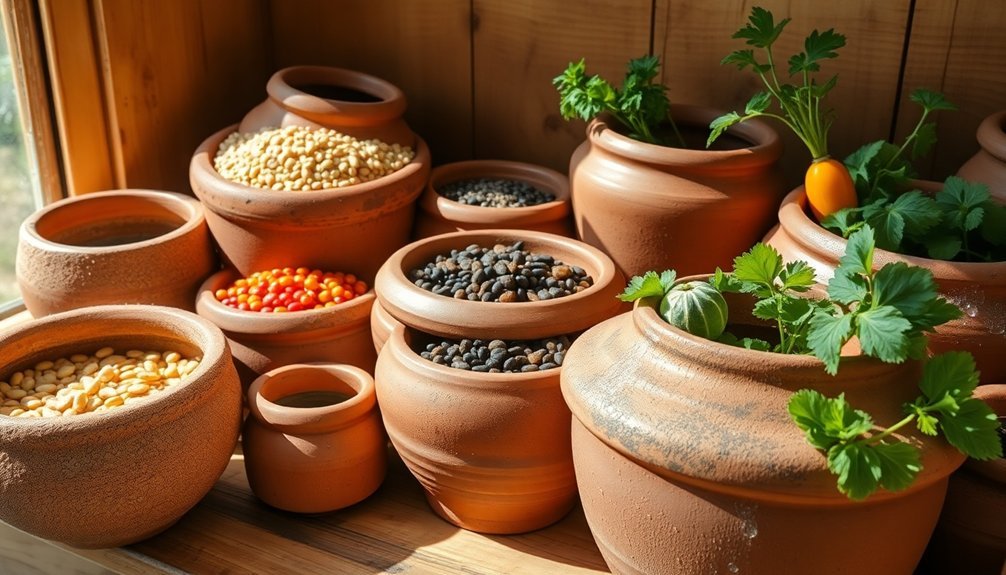
Through the natural properties of clay, food storage in earthenware vessels offers remarkable nutritional advantages. When you store food in clay pots, you're benefiting from their unique ability to preserve nutrients while enhancing the food's natural flavors.
The porous nature of clay allows your food to breathe while maintaining essential moisture levels, guaranteeing nutrients aren't lost during storage.
You'll find that clay pots naturally enrich your stored food with beneficial minerals like calcium, phosphorous, iron, magnesium, and sulfur. These vessels don't just preserve nutrients – they actually contribute to your food's nutritional value.
The alkaline nature of clay helps balance the acidity in your stored foods, making them easier for your body to digest when consumed.
The non-reactive properties of clay assure that your stored food remains uncontaminated by unwanted chemical reactions. You won't need to worry about toxins or anti-nutrients, as clay's natural composition helps reduce their concentration.
Additionally, the even temperature distribution within clay vessels helps maintain your food's nutritional integrity, guaranteeing you get the maximum health benefits from your stored ingredients.
Sustainable Kitchen Storage Practices
Modern sustainable kitchen storage practices can transform the way you preserve food while protecting the environment. By adopting eco-friendly storage solutions, you'll reduce waste, save money, and maintain food freshness longer.
Start by replacing single-use plastics with reusable alternatives like glass jars, stainless steel containers, and silicone bags. These options aren't just better for the environment; they're also safer for your food and more cost-effective in the long run.
To maximize your sustainable kitchen storage, follow these essential practices:
- Use beeswax wraps instead of plastic wrap – they're natural, reusable for up to a year, and perfect for covering bowls or wrapping produce.
- Implement proper preservation techniques like canning, freezing, or fermenting to extend food shelf life and reduce waste.
- Group similar items together using labeled bins and designated storage areas to prevent forgotten foods from spoiling.
- Invest in quality containers that are dishwasher safe and designed for specific storage needs, such as breathable cotton bags for leafy greens or vacuum-seal containers for dry goods.
Remember to repurpose clean glass jars whenever possible to further minimize your environmental impact while maintaining an organized kitchen.
Flavor Enhancement Through Clay
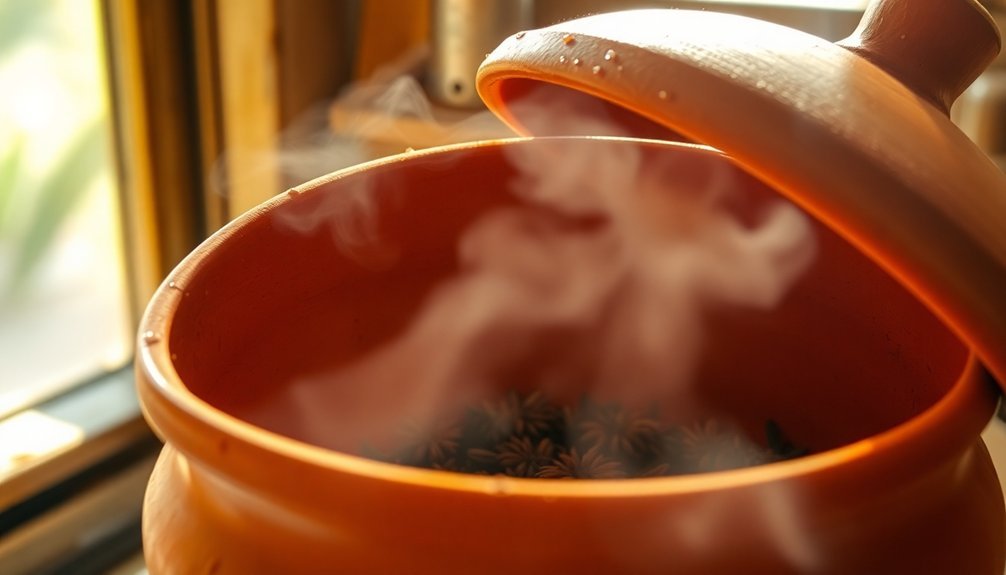
Clay pots offer a remarkable way to augment the flavors of stored and fermented foods through their unique mineral composition and porous structure. You'll notice that food stored in clay vessels develops a distinctive earthy taste that many find appealing, especially in items like curd and buttermilk.
When you store food in clay containers, you're not just preserving it – you're enriching it. The clay's minerals, including magnesium, calcium, phosphorus, and iron, naturally seep into your food, while its alkaline nature balances acidic contents.
You'll need less oil when cooking, as the clay's natural moisture helps cook food thoroughly.
You'll find clay pots particularly effective for fermentation processes. They're ideal for making foods like sauerkraut, kimchi, and yogurt because their porous nature supports beneficial bacterial growth.
The natural cooling effect of clay also keeps your food fresh through evaporative cooling, working like a natural refrigerator.
The clay's ability to retain heat and moisture while allowing food to breathe guarantees that your stored items maintain their nutritional value while developing richer, more complex flavors.
Whether you're fermenting, storing, or cooking, clay pots consistently enhance your food's taste and quality.
Health-Conscious Food Preservation
Preserving food's nutritional value stands at the forefront of health-conscious storage methods, and clay pots excel in this department. You'll find that these vessels naturally maintain your food's moisture while cooking slowly and evenly, guaranteeing vitamins and minerals stay intact.
When you're using glazed clay pots, you're also protecting your food from harmful substances that could leach from untreated clay.
You don't need to add extra fats when cooking in clay pots, as their porous nature allows food to cook in its own juices. This natural cooking process not only reduces the overall fat content of your dishes but also helps preserve essential nutrients that high-heat cooking methods often destroy.
Here's what you can expect from clay pot food storage:
- Extended shelf life for fruits and vegetables through evaporative cooling
- Leafy greens staying fresh for over four days, compared to one day at room temperature
- Reduced food spoilage without electricity
- Better nutrient retention through moisture preservation
When selecting clay pots for storage, always choose properly glazed options to guarantee you're avoiding potential heavy metal contamination while maximizing the health benefits of this ancient storage method.
Earthen Storage Methods
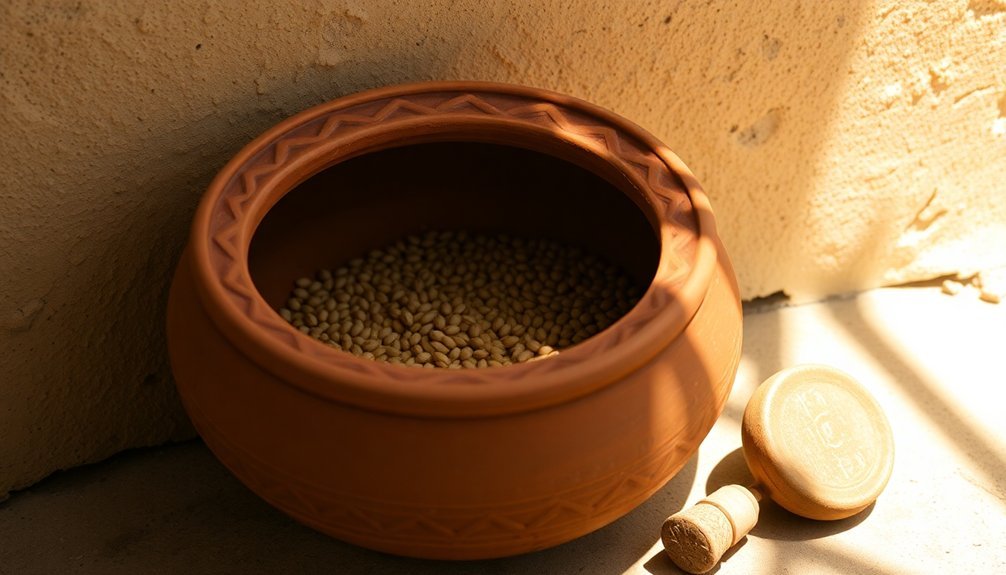
You'll find that clay pots, among humanity's oldest storage solutions, continue to offer remarkable benefits for modern food preservation needs.
The natural properties of clay provide superior nutrient retention, extend shelf life through evaporative cooling, and enhance water quality through alkalization and purification processes.
These time-tested earthen storage methods remain relevant today, offering you a sustainable and effective way to store food without electricity while maintaining its nutritional value.
Ancient Techniques Still Relevant
Throughout history, ancient civilizations developed remarkably effective storage methods that remain practical today. Their ingenious use of clay pots and earthen storage techniques wasn't just primitive innovation – it was based on sound principles that you can still apply to your food storage needs.
Clay pots, in particular, stand out as a sustainable storage solution you'll want to take into account. Their porous nature helps maintain ideal moisture levels while protecting your food from external threats. You'll find these ancient methods particularly useful because they don't require electricity or modern technology to work effectively.
Here's why these time-tested storage techniques still make sense today:
- Clay pots naturally regulate temperature and humidity through evaporative cooling, helping preserve your food longer.
- The porous structure allows food to "breathe" while preventing excess moisture buildup that leads to spoilage.
- You can seal clay containers with wet clay and pottery shards to create an effective barrier against pests and moisture.
- These containers are environmentally friendly, sustainable, and can last for years with proper care.
When you're looking for reliable food storage methods, these ancient techniques offer proven solutions that are both practical and eco-conscious.
Natural Preservation Systems
Beyond clay pots, natural earthen storage methods offer reliable ways to preserve food without modern technology.
Root cellars provide one of the most effective solutions, maintaining consistent temperatures and humidity levels that can keep your produce fresh for months. You'll find these underground structures particularly useful for storing root vegetables and fruits, whether you construct a dedicated cellar or utilize an unheated basement.
If you're looking for simpler options, you can try underground burial techniques using soil or straw. This method takes advantage of the earth's natural temperature regulation to protect your food from frost and extreme weather changes.
For dry climates, zeer pots create a natural cooling system through evaporation, though they won't work effectively in humid areas.
Sand storage presents another versatile option you can implement in various settings, from root cellars to refrigerator drawers.
When storing vegetables in sand, remember not to wash them beforehand to prevent excess moisture. You'll need to guarantee proper ventilation, but this method works exceptionally well for root vegetables, onions, leeks, shallots, and cauliflower.
Clay Storage Benefits Today
Modern civilization's reliance on electricity hasn't diminished clay storage's remarkable benefits. You'll find that clay pots offer sustainable food preservation without the need for power, making them particularly valuable in areas with limited electrical access.
These vessels work through evaporative cooling, lowering temperatures by up to 10°C below ambient conditions, which considerably extends the shelf life of your produce.
When you're looking to maximize food preservation, clay storage offers these key advantages:
- You'll preserve more nutrients since clay pots cook and store food slowly, preventing nutrient loss while adding essential minerals like calcium and iron.
- Your food stays fresher longer through the natural evaporative cooling process, especially in arid climates.
- You'll reduce your environmental impact by eliminating the need for electric appliances.
- You can adapt these storage methods to various settings, from urban apartments to rural homes.
Clay storage solutions, like zeer pots and root cellars, provide practical alternatives to modern refrigeration.
You'll find they require minimal maintenance while offering efficient food preservation, helping you maintain food security and reduce waste through natural, time-tested methods.
Environmental Impact of Clay Storage
You'll find that clay storage vessels offer significant environmental advantages through their naturally renewable source material – earth itself.
Your clay containers won't leave harmful chemical residues in the environment, as they're made from pure, unprocessed materials that return safely to the earth at the end of their lifecycle.
When you choose clay storage, you're contributing to minimal waste generation since broken vessels can be ground down and recycled into new pots or safely returned to the soil.
Renewable Material Source
Clay's status as a renewable resource makes it an environmentally conscious choice for food storage containers. When you choose clay pots, you're selecting a material that's naturally abundant and continuously replenished through geological processes.
The extraction of clay requires minimal mechanical processing, which greatly reduces energy consumption compared to synthetic materials.
You'll find that clay's environmental benefits extend beyond its renewable nature. Local sourcing plays an essential role in minimizing transportation-related emissions, while proper extraction methods help preserve the surrounding ecosystem. The material's abundance means you won't have to worry about depleting Earth's resources.
Here are the key environmental advantages of clay as a renewable source:
- Natural extraction processes require minimal energy and mechanical processing
- Local sourcing reduces transportation emissions and supports regional economies
- Clay deposits replenish naturally over time through geological processes
- Extraction can be managed sustainably with minimal impact on ecosystems
Zero Chemical Footprint
Four key environmental benefits make clay storage containers stand out for their zero chemical footprint. You'll greatly reduce greenhouse gas emissions by preventing food waste, which currently generates 4.4 Gt CO2 equivalent annually. Unlike refrigeration systems, clay pots don't require electricity or synthetic materials, operating purely through evaporative cooling principles.
| Environmental Factor | Clay Storage Impact |
|---|---|
| Chemical Leaching | No harmful substances transferred to food |
| Energy Usage | Zero electricity consumption |
| Production Impact | Minimal industrial processing required |
The natural materials used in clay pots – clay, sand, and water – guarantee you're not introducing harmful chemicals into your food storage system. Unlike glazed cookware that can leach heavy metals, these storage containers don't pose contamination risks since they're not used for cooking. You're also contributing to lower agricultural emissions, as better food preservation means less need for excess food production. The manufacturing process itself leaves a minimal environmental footprint, with local production reducing transportation emissions. When you choose clay pot storage, you're supporting a storage solution that aligns perfectly with UN Sustainable Development Goals, particularly responsible production and consumption practices.
Minimal Waste Generation
Through innovative waste reduction practices, clay pot storage systems greatly minimize environmental impact across multiple fronts.
You'll find these systems particularly effective in reducing food waste, especially in Sub-Saharan Africa, where 30-50% of produce typically spoils during transport or market storage.
When you use clay pot coolers, you're actively participating in waste reduction that aligns with UN Sustainable Development Goals.
The waste reduction benefits of clay pot storage are substantial:
- You're cutting down on greenhouse gas emissions, as food waste typically generates 4.4 Gt CO2 equivalent annually.
- You're helping reduce the need for additional agricultural production by preserving existing produce longer.
- You're minimizing resource waste through the use of locally available, inexpensive materials.
- You're decreasing the environmental impact of food transportation and storage.
Frequently Asked Questions
How Long Does a Clay Pot Typically Last Before Needing Replacement?
Your clay pot's lifespan varies greatly based on your care and handling. While it can last years with proper maintenance, you'll need to replace it if it cracks, breaks, or develops serious wear.
Can Clay Pots Be Safely Cleaned in a Dishwasher?
You shouldn't put clay pots in the dishwasher as they can crack from high heat and water pressure. It's best to hand wash them with warm water and mild soap to preserve their integrity.
What Types of Foods Should Never Be Stored in Clay Pots?
You shouldn't store acidic foods, raw meats, high-fat items, or strong-smelling foods in clay pots. They can react with the clay, cause contamination, be difficult to clean, and leave lingering odors.
Do Clay Pots Require Special Maintenance During Different Seasons?
Yes, you'll need different maintenance for your clay pots throughout the year. In summer, soak them before use and water frequently. During winter, clean them thoroughly and store in a dry place to prevent cracking.
Can Broken Clay Pots Be Repaired for Continued Food Storage Use?
You can repair minor cracks in clay pots with copper wire stabilization and oil treatment, but if there's significant damage, it's safer to replace them for food storage to avoid contamination risks.
In Summary
You'll find clay pots offer a remarkable solution for natural food storage that aligns with both ancient wisdom and modern sustainability goals. They'll keep your food fresh while enhancing flavors naturally, all without electricity or harmful chemicals. Whether you're storing grains, vegetables, or water, clay vessels provide a healthier, more environmentally conscious choice that's stood the test of time.

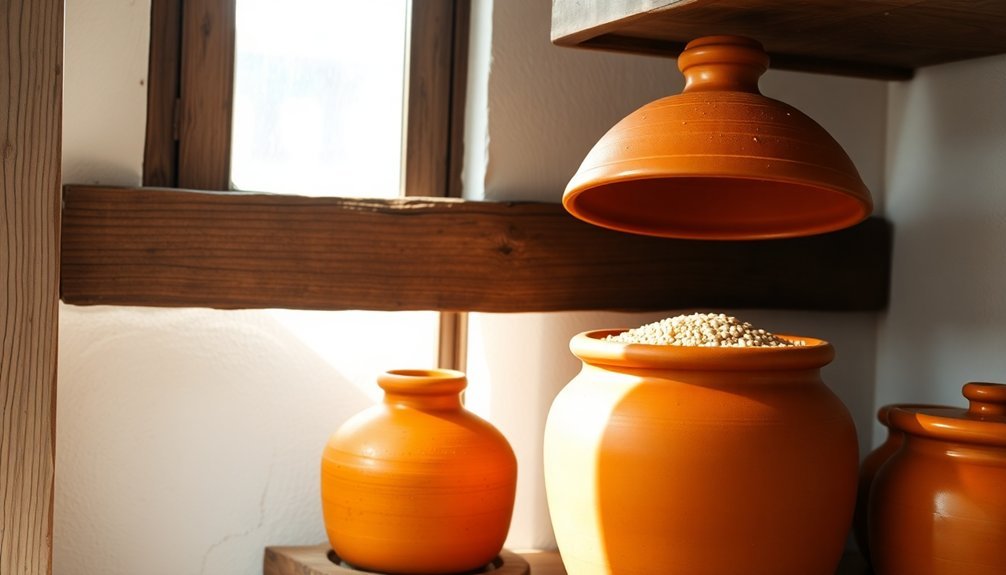



Leave a Reply